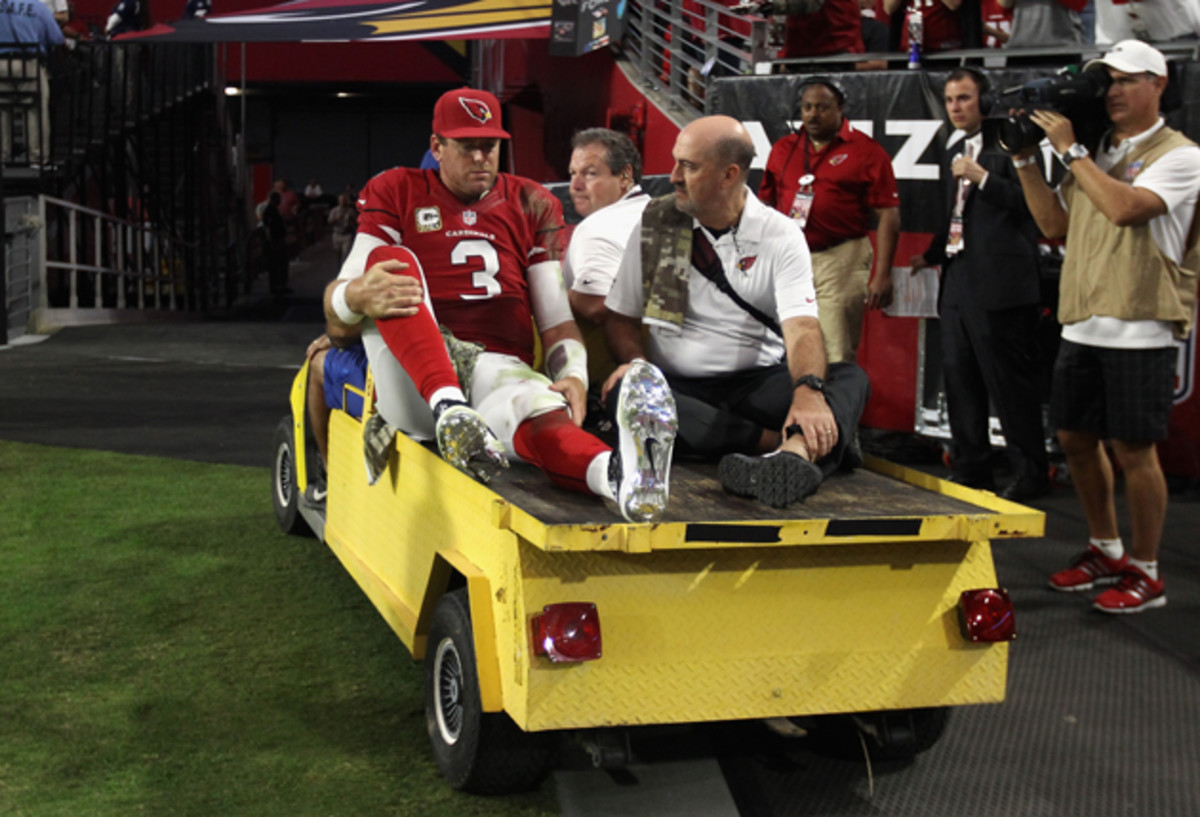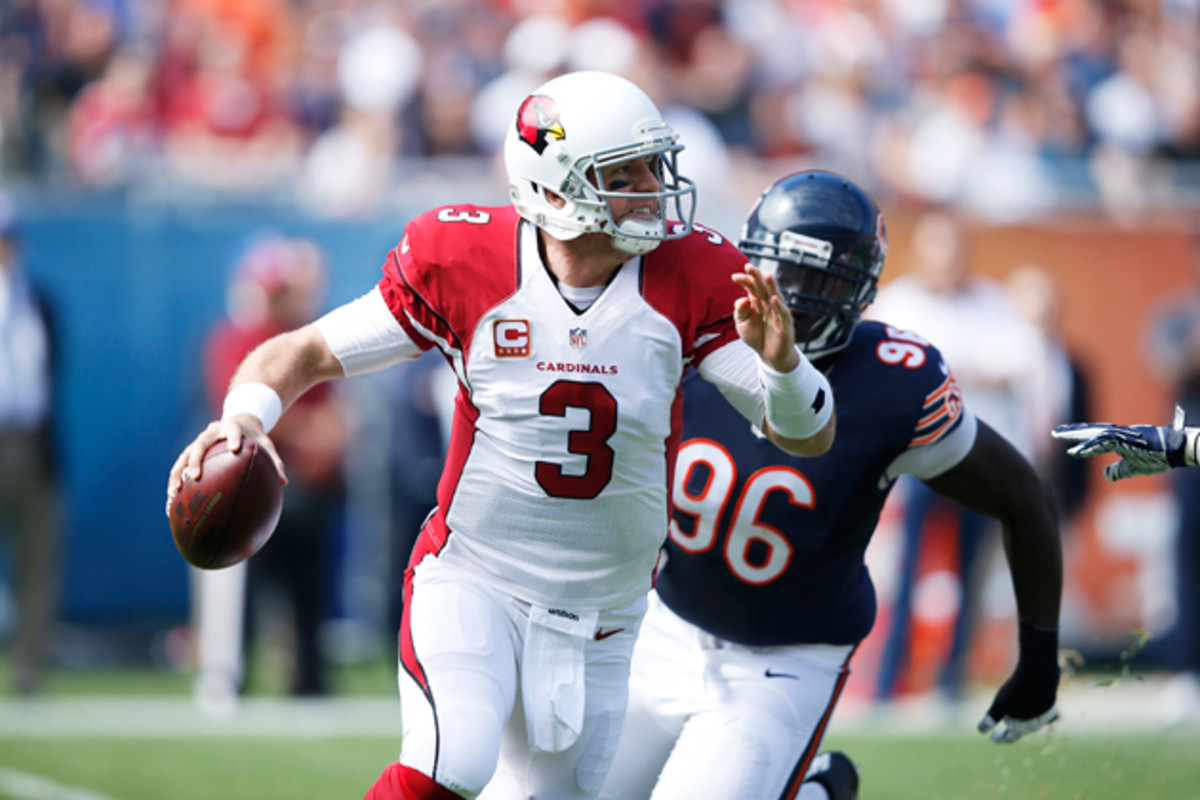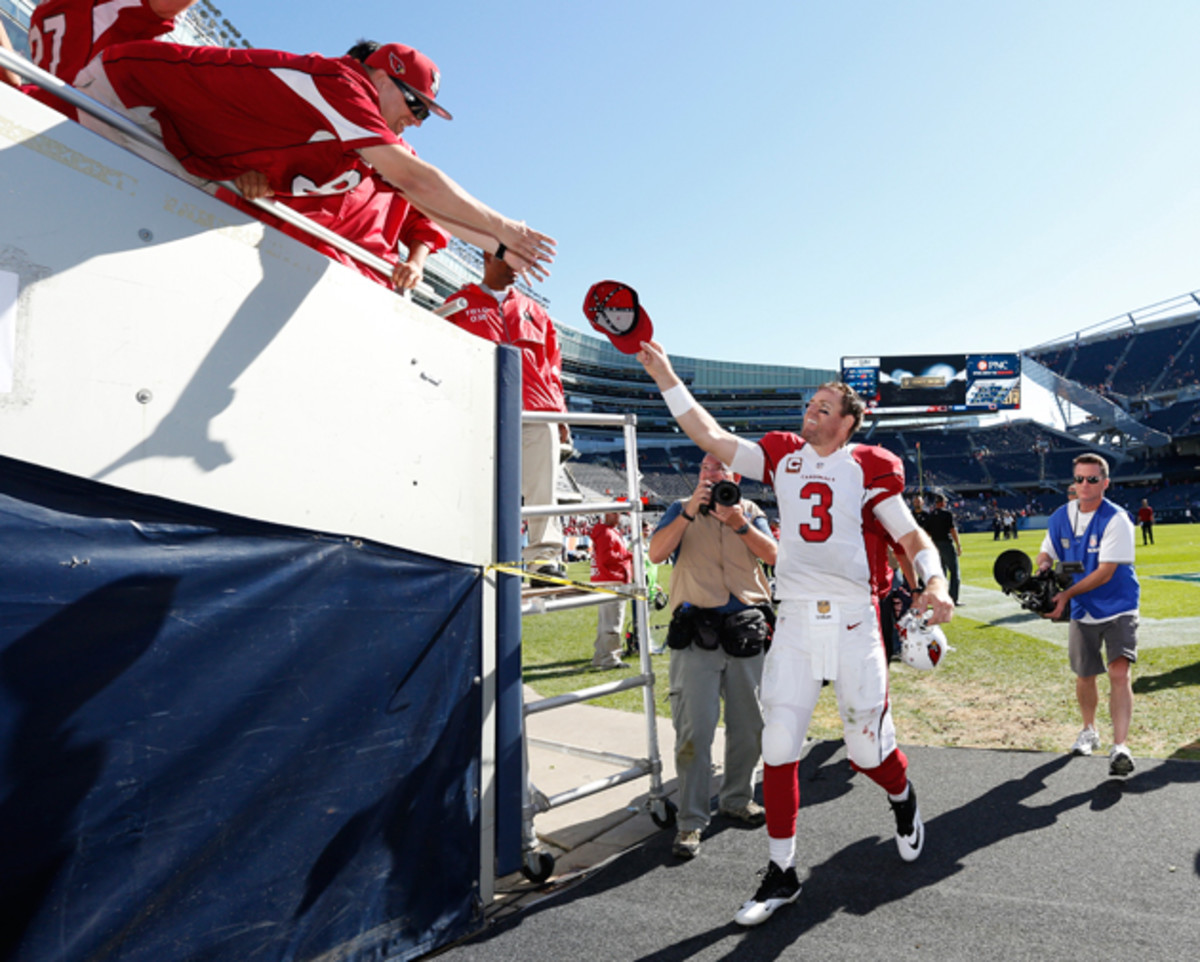The Comeback: The story behind the reemergence of QB Carson Palmer

To borrow loosely from Neil Armstrong, it was one small step for a man. After taking a shotgun snap in the first quarter of the Cardinals’ season opener on Sept. 13, Carson Palmer moved his weight to his back (right) foot, poised to throw. Finding no open receivers, he shifted the weight to his front (left) foot before pushing off that foot, rolling out to his right, scanning the field, buying time—three, four, five seconds—and finally rifling a 10-yard touchdown pass to his sometime house guest and babysitter, second-year receiver John (Smokey) Brown.
That play was significant on several levels. It staked the Cardinals to an early lead in what would be a 31–19 victory over the Saints. It capped Palmer’s first regular-season drive in the 308 days since last Nov. 9, when he tore his left ACL against the Rams. And it provided further proof of what his Arizona teammates had observed in the preseason: that the 35-year-old quarterback has not just returned to his former level of excellence—Palmer had won 13 of his previous 15 starts—but transcended it. Following the Cardinals’ third straight victory to open this season, a 47–7 demolition of the 49ers on Sunday, Palmer’s nine touchdown passes (against just two interceptions) were tied for the NFL lead, and his 117.8 passer rating was fourth best among full-time starters.
That push-off, incidentally, was almost identical to the ungainly rocker step—shifting his weight back, forward, then back again—that felled Palmer last season. “Now that I think about it,” Palmer said earlier this month, “that’s exactly what I did last time, when the ACL failed. But this is the first time I’ve thought about it.”
That’s a good thing, considering the flashbacks that plagued the QB during his first comeback from left-ACL surgery. That operation, far more extensive, was necessitated in January 2006 after the second offensive snap of the Bengals’ first playoff game in 15 years. A borderline cheap shot by 300-pound Steelers tackle Kimo von Oelhoffen caved in the knee, tearing most of its connective tissue and dislocating the kneecap. Rating the seriousness of that injury “on a scale of one to three,” said the surgeon who operated on Palmer, “this is a four.”
The Comeback: How Angels fireballer Garrett Richards regained his groove
“It took me a full year, plus another six, seven games into the next season, to really feel comfortable again and not see ghosts,” recalls Palmer. “There would be times when I’d drop back and I’d see color flash, and I’d pull my leg back or not step into a throw because the memory was fresh.
“This time, with this injury, I haven’t seen any ghosts.”
Here’s what he is seeing, more clearly than at any time in his 12-year career: the field, the intentions of opposing defensive coordinators and a path to the postseason. Palmer was 33 after his 2012 campaign and, having just completed two miserable seasons in Oakland (where he was 8–16), widely believed to be in the deep twilight of his career. Jettisoned by Raiders brass in a deal involving late-round draft picks, he arrived in Arizona with new coach Bruce Arians, the quarterback whisperer who has mentored Peyton Manning, Ben Roethlisberger and Andrew Luck, and who recently said of Palmer, “He’s playing [at] as high a level right now as anybody I’ve ever coached.”
Between being picked No. 1 in the 2003 draft out of USC and joining the Cardinals, Palmer spent a mostly Sisyphean decade in the NFL. And while the mediocrity of his surrounding casts with the Bengals and the Raiders never could dim his reputation as an elite quarterback, his learning curve under Arians that first season was steep. The coach known as BA runs a complex, field stretching, opportunistic attack that demands both a formidable football intellect and a high level of trust in the system. Palmer had plenty of the former but not enough of the latter.
By the middle of last season, though, his grasp was much surer. “He trusts everybody,” Arians revealed last November. “Instead of seeing guys come open, then throwing, he’s throwing ’em open. Guys turn their head—the ball’s there.”

Then, five days later—just two days after Palmer signed a three-year, $50 million extension—his season was over. But even as he put his body through intensive rehab, Palmer kept his head in the game, says Arians, “watching film and learning more of our offense.” In July, as he has almost every season he’s been in the league, Palmer invited his receivers to Camp Carson, a post-minicamp, pre-training-camp week of route-drill work at a high school near his home, north of San Diego.
“We lifted weights, worked out, went over hot reads,” says Brown, who crashed in a guest room at Palmer’s house. “Mostly, he’s giving me the heads-up on how to adjust more quickly, play faster.” Palmer’s hospitality was motivated at least a little by self-interest: “Having [Brown] around is great because, when I come home tired from a workout, my kids don’t come running up to me to see if I want to play—they go straight to Smokey, who’s just run 480 routes. I get to sit on the couch, and he’ll run around with them, swim, play basketball. He’s got a three-year-old daughter of his own, and he’s phenomenal with kids.”
While Brown, the pride of Division II Pittsburg (Kans.) State, is Arizona’s most potent vertical threat, Palmer’s go-to target remains the redoubtable Larry Fitzgerald, who’s hauled in 17 catches for 246 yards and five touchdowns in Arizona’s last two games, marking the 32-year-old’s best two-week stretch since Arians informed him two seasons ago that he’d be moving inside to the more hardscrabble neighborhood of the slot.
Training with Lavonte David: A dual workout provides a singular payoff
“I feel it building every week,” Palmer says of his understanding of Arians’s scheme. “I feel very comfortable, but I don’t feel at all like I’ve got it. And I want to keep that feeling, because that’s what keeps me up late and gets me back in the building early Monday mornings and Tuesdays [the players’ day off]. But I’m extremely confident in what I’m doing and in the guys around me, throwing balls before they’re breaking, feeling holes open and delivering the ball off of feel.”
Clearly, he is delivering it with more zip—when the occasion merits—and accuracy than before his latest ACL tear. In and out of the pocket he’s moving more spryly than he has in a long time, leading Arians to estimate that his quarterback, post-rehab, seems “five years younger.” (The subject of his deceptive speed is one Palmer prefers to keep on the down-low. “People think I’m slow,” he says. “They don’t take good angles, and I’m able to scramble around, make plays every once in a while.”)
This much we know: He has come a remarkably long way since running and he crumpled, untouched, to the turf a little less than 11 months ago. Impassive under his ball cap as he was carted off the field, Palmer waited until he got home before allowing himself a good cry.
“It took me a full year, plus another six, seven games into the next season, to really feel comfortable again and not see ghosts,” recalls Palmer.
What provoked those tears? Sadness? Frustration? Rage at the universe for the unfairness of it all? Certainly not the last, says Palmer. “I’ve never asked, Why me? I have so many things to be grateful for.”
The catharsis came with the full realization that his 2014 season—so pregnant with promise during Arizona’s 7–1 start—was over. “I gave myself that night just to not be Dad or the quarterback or the captain, to just let my emotions go so I could move on to the next stage: the surgery, the rehab and the recovery.”

Silver lining number 1: Palmer had the playbook from the first time he’d blown out his left knee and was thankful to have that experience to fall back on. He could brace himself, he says, for those unpleasant days when “they hold your leg and snap down your knee to get the scar tissue out,” could gird himself against the monotony of the three weeks of box work, a gauntlet of 25 workouts “where you’re stepping up on boxes and it’s so boring. And tedious. And long. And annoying.”
Silver lining number 2: As long as he was going to “re-learn those motor patterns,” in the parlance of his Carlsbad, Calif.–based trainer and speed coach, Ryan Flaherty, Palmer decided to use the opportunity to tweak and improve his mechanics too. This retooling took place under the guidance of Flaherty, Cardinals physical therapist Brett Fischer and strength coach Buddy Morris, and Jordan Palmer, Carson’s 31-year-old brother, who was his backup for three seasons in Cincinnati. And while that crew did not include one Oscar Goldman, who intones at the beginning of The Six Million Dollar Man, “We can rebuild him; we have the technology,” Palmer’s retinue did help its $50 million man come back better, stronger, faster.
“When Carson first got to me,” recalls Flaherty, who began working with the QB early last January, roughly six weeks after the surgery, “his lower-body strength-to-weight ratio was around 1.7 times his body weight. Ideally, for an NFL quarterback, you want to be about 2.5.”
Palmer increased that strength by performing, among other exercises, deadlifts with a six-sided bar. He endured single-leg balance and stabilization exercises (squats, etc.) to build strength “from the feet up,” says Flaherty, and isolated “those little stabilizer muscles” around the knee joint—particularly the VMO, or vastusmedialis oblique, just above and inside the kneecap. On the field he suffered through countless sprints and change-of-direction drills. And at some point rehab became rejuvenation. Between the weight work and the speed work, says Flaherty, “[Carson] is stronger and faster than he’s been in the last eight to 10 years.”
He’s also more efficient, which is where Palmer’s kid brother comes in. Throughout his own seven-year professional career, Jordan, now a free agent, has moonlighted as a quarterback coach. And by studying Carson’s videotaped workouts this off-season, he noticed that “as [Carson] went through his progressions, his feet got a little wide, he sank back on his back leg, and he had a little bit of an overstride.”
Overstriding, as Jordan can tell you, is a gateway flaw. “When you overstride,” he explains, “your back hip doesn’t fire enough,” which can result in the dropping of one’s throwing elbow, which leads to overcompensating by “coming way more over your front foot,” at which point “the ball’s not going to feel right in your hand, it starts to get funky, and guys try to fix it at the last second.” All of that can cause scattershot throws, damaged confidence, the waiver wire.
Palmer’s crew tailored their drills to prevent Carson from, in his words, “taking such big steps, getting my foot so far off the ground.” By standing taller in the pocket—and at the same time taking shorter, quicker steps—he’s now better able to see the field and react to what he sees. “It’s not that you stopped on a dime or hurdled somebody or did a backflip,” Jordan told his big brother after that win over the Saints. “You just looked really confident in your ability to extend the play.”

Can this new and improved Carson Palmer extend the Cardinals’ season, though? Early portents are favorable, especially in the NFC West. With two losses already, the Seahawks seem to have come down in the world.
Reports of a resurgence by the Rams appear to have been at least slightly exaggerated. And the 49ers are in free fall. The postseason, should Arizona return to it, will provide unfamiliar surroundings for Palmer. He threw one pass in that catastrophic cameo against the Steelers, a 66-yarder to the late Chris Henry—the same play on which Von Oelhoffen came in late and low. And five years ago with Cincinnati he was outplayed in the wild-card round by fellow USC alum and then Jets rookie Mark Sanchez (his short-lived Gotham tabloid nickname in those heady weeks: The Sanchise!) in a 24–14 loss. Palmer hasn’t taken a postseason snap since. He was looking on helplessly last January, during the Cardinals’ 27–16 wild-card loss to the Panthers, as emergency starter Ryan Lindley led Arizona to 78 yards of offense, the lowest total in NFL playoff history.
What if Palmer fizzles under January’s brighter lights? What will it mean in the grand scheme? He’s accomplished plenty, winning the 2002 Heisman Trophy, playing in two Pro Bowls, claiming the NFL’s Ed Block Courage Award for his comeback from that first, grisly knee injury. He has earned the respect of the people who matter to him. Shouldn’t that be enough? Or will there be a hole in his résumé if he fails to lead this team deep into the postseason?
Palmer’s answer: a definitive yes. “Because at the end of every season, it doesn’t matter if you went 15–1 and lost in the first round. All that matters is what happens when it starts getting really cold. That’s what I’m playing for.”
The outlook is bright. “This is the best opportunity I’ve had,” Palmer says. “It’s the most exciting time of my career. It’s the most fun I’ve had playing the game. It’s the most free I’ve felt.”
It helps when you’re not seeing ghosts.
